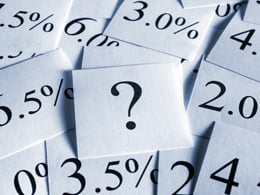 I was pretty much right on my take that the Federal Reserve would choose not to raise rates yesterday. The U.S. economy is doing well, according to the statement, but rates will remain at zero due to worries about financial markets and the rest of the world. Waiting a bit longer has little downside compared with the risks of acting now—or so the Fed apparently believes.
I was pretty much right on my take that the Federal Reserve would choose not to raise rates yesterday. The U.S. economy is doing well, according to the statement, but rates will remain at zero due to worries about financial markets and the rest of the world. Waiting a bit longer has little downside compared with the risks of acting now—or so the Fed apparently believes.
2 things to take from the Fed’s decision
- The Fed appears to have extended its mandate from unemployment and inflation to the financial markets. This has been implicit for years, of course, so it’s not a surprise. But it is interesting to see it acknowledged.
- The Fed is now looking much more to the rest of the world in setting policy. U.S. growth is all right, again per yesterday’s statement, but perhaps rates should stay at zero until the world as a whole starts to grow. This is new.
The Fed has always been aware of and taken the rest of the world into account, but, for legal and political reasons, it has never explicitly invoked global financial health as a reason for policy. Indeed, per its statutory goals, the Fed should not be invoking this now. Because it has no real ability to affect foreign economies, I would argue that the Fed should stay focused on the U.S. economy and that this comment was a mistake.
International markets spooked
International markets seem to agree. The statement focused on worries about international economies and markets, and those comments seem to have spooked markets in Europe and much of Asia. Even markets in the U.S. are reacting negatively as I write this. By raising questions about issues it has no ability to affect, the Fed has injected itself into a wider debate where it really has no place.
By keeping rates low, in the hopes of stemming market turmoil, the Fed has let everyone know that, even with the ongoing U.S. recovery, it is still not confident enough to move policy away from emergency levels. By attributing this to international markets, it raises very serious questions as to just how weak those economies and markets are—which increases uncertainty, and hurts markets, across the board.
The actual communication from the Fed was a mixed bag. Most members now expect a rate hike in 2015, which would mean in October or December, and, as expected, the dot plot reflects this. At the same time, expected inflation has been revised down for the next several years, as have additional rate increases over that time period.
The worst of both worlds
If the Fed wanted to reduce uncertainty and market risk with this decision, it failed. While markets were not expecting a rate hike, they were expecting some more clarity. By not providing that clarity here in the U.S., and provoking worry about international markets, the Fed has actually gotten the worst of both worlds.
What does this mean for markets? In the short term, it is negative, with lower confidence and more downside risk. In the medium term, it also raises the risks associated with later rate decision meetings. With no clear guidance on when or if rates will actually go up, we continue in a state of uncertainty, exacerbated by the knowledge that the Fed is sufficiently worried about the financial and international markets to keep rates at emergency levels, despite a strengthening U.S. economy.
Not, I think, what the Fed intended to accomplish.


 Print
Print


